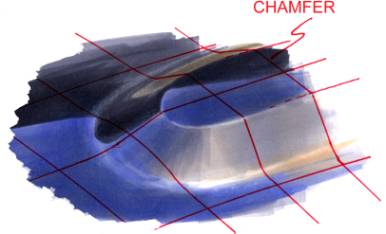|
|
|
|
||
| Form Glossary | ||
For the most part, the glossary below consists of nouns to describe some basic surfaces, as well as terms which describe what a surface is doing. Often an adjective will lead to a verb or noun, or vice-versa, as in a curve may have acceleration, or you can accelerate the curvature and create an accelerated curve. As well, there are odds and ends of terms that describe specific occurrences of form, such as blister. This is certainly not an exhaustive list, simply a starting point. You should feel free to add your own terms to your personal vocabulary as you begin to identify certain developments of form that occur in your work. The important thing is to grow a vocabulary that can be shared with the people you need to communicate your design with, as well as an aid to your own visualization of form. As wizards and scientists believe, once a thing is named, it can be more easily identified, isolated, and controlled. Keep in mind as well that these are not dictionary definitions, just my own understanding of how the terms are used to describe form. Accelerate (curve, line, surface) v: to increase the rate of curvature over the length of a surface or line. |
||
|
|
||
|
Acceleration becomes obvious on a shiny or reflective surface, as highlights and reflections will appear to 'travel' quicker over the more curved sections of the surface. Arc n: A section of a circle. A curved line with a constant radius. Bevel n: A flat surface formed by cutting off the edge where two surfaces meet. v: To cut off the edge or corner of a surface. |
||
|
||
|
Blister n: a distinct, convex surface emerging from a less rounded surface, delineated with a hard intersection. Opposite of dimple. v: to pull a crisply delineated area of deep convexity out of a less rounded surface. Bone
n: The rounded intersection between two surfaces where highlights
gather. A tightening of curvature on a surface, forming the appearance
of skin stretched over a bone. Chamfer v: To cut off the top of a protruding surface, creating a flat plateau whose edge describes the cross-section of the surface. |
||
 Chamfer |
||
Coke-bottle/ Wasp-waist n: A generally symmetrical, curved form which narrows near the mid-point. |
||
| > Form Glossary Continued... |
 |